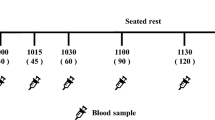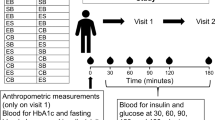Abstract
Background/Objective:
To determine gastrointestinal (GI) responses and maximum tolerated dose of erythritol in young children given as a single oral dose in a 250-ml non-carbonated fruit-flavoured beverage in between meals. This is a multicentre double-blind study with sequential design for multiple dose groups and randomised crossover for comparators of placebo vs dose.
Subjects/Methods:
A total of 185 healthy young children aged 4–6 years were recruited at three clinical investigation centres after informed consent of both parents; 184 children completed the study. Children were included in one of the four dose groups (5, 15, 20 or 25 g erythritol) and exposed randomly to only one single dose vs an isosweet sucrose placebo. After consumption in the clinic and an observation period, GI symptoms and stooling patterns were recorded during the next 48 h.
Results:
Statistically significantly more episodes of diarrhoea and/or severe GI symptoms were observed in the 20 and 25 g groups compared with placebo, but not in the 5 and 15 g groups. Stool consistency, as measured by Bristol stool scale, was lower in the 15-, 20- and 25 g groups for the first 24 -h period, but not at later time points. Incidences of nausea, vomiting, borborygmi, excess flatus and abdominal pain were not significantly different from the placebo controls at all doses of erythritol.
Conclusions:
Rapid ingestion of up to and including 15 g (6% w/v) of erythritol in a beverage in between meals by young children aged 4–6 years was well tolerated. The no observed effect level for diarrhoea and/or severe GI symptoms was 15 g (0.73 g/kg body weight (bw)). Children appeared not to be more sensitive to the GI effects of erythritol than published for adults on a g/kg bw basis.
This is a preview of subscription content, access via your institution
Access options
Subscribe to this journal
Receive 12 print issues and online access
$259.00 per year
only $21.58 per issue
Buy this article
- Purchase on Springer Link
- Instant access to full article PDF
Prices may be subject to local taxes which are calculated during checkout

Similar content being viewed by others
References
de Cock P . Erythritol. In: O'Donnell K, Kearsley M (eds) Sweeteners and Sugar Alternatives in Food Technology. Wiley-Blackwell, 2012, pp 213–241.
Bernt WO, Borzelleca JF, Flamm G, Munro IC . Erythritol: a review of biological and toxicological studies. Regul Toxicol Pharmacol 1996; 24: S191–S197.
EU. European Union Commission Directive 2008/100/EC of 28 October 2008 amending Council Directive 90/496/EEC on nutrition labelling for foodstuffs as regards recommended daily allowances, energy conversion factors and definitions. Official J Eur Union 2008; 51 (L 285), 9–12.
Kawanabe J, Hirasawa M, Takeuchi T, Oda T, Ikeda T . Noncariogenicity of erythritol as a substrate. Caries Res 1992; 26: 358–362.
Bornet FR, Blayo A, Dauchy F, Slama G . Plasma and urine kinetics of erythritol after oral ingestion by healthy humans. Regul Toxicol Pharmacol 1996a; 24: S280–S285.
Ishikawa M, Miyashita M, Kawashima Y, Nakamura T, Saitou N, Modderman J . Effects of oral administration of erythritol on patients with diabetes. Regul Toxicol Pharmacol 1996; 24: S303–S308.
Livesey G . Health potential of polyols as sugar replacers, with emphasis on low glycaemic properties. Nutr Res Rev 2003; 16: 163–191.
Bornet FR, Blayo A, Dauchy F, Slama G . Gastrointestinal response and plasma and urine determinations in human subjects given erythritol. Regul Toxicol Pharmacol 1996b; 24: S296–S302.
Hiele M, Ghoos Y, Rutgeerts P, Vantrappen G . Metabolism of erythritol in humans: comparison with glucose and lactitol. Br J Nutr 1993; 69: 169–176.
Noda K, Nakayama K, Oku T . Serum glucose and insulin levels and erythritol balance after oral administration of erythritol in healthy subjects. Eur J Clin Nutr 1994; 48: 286–292.
Noda K, Nakayama K, Modderman J . Fate of erythritol after single oral administration to rats and dogs. Regul Toxicol Pharmacol 1996; 24: S206–S213.
Oku T, Noda K . Erythritol balance study and estimation of metabolisable energy of erythritol. In: Hosoya N (ed) Proceedings of the International Symposium on Caloric Evaluation of Carbohydrates. Japan Association of Dietetic and Enriched Foods: Tokyo, Japan, 1990, pp 65–75.
Tetzloff W, Dauchy F, Medimagh S, Carr D, Bar A . Tolerance to subchronic, high-dose ingestion of erythritol in human volunteers. Regul Toxicol Pharmacol 1996; 24: S286–S295.
Schiweck H, Ziesenitz SC . Physiological properties of polyols in comparison with easily metabolisable saccharides. In: Grenby TH (ed) Advances in Sweeteners. Springer US: Glasgow, UK, 1996, pp 56–84.
Arrigoni E, Brouns F, Amado R . Human gut microbiota does not ferment erythritol. Br J Nutr 2005; 94: 643–646.
Munro IC, Berndt WO, Borzelleca JF, Flamm G, Lynch BS, Kennepohl E et al. Erythritol: an interpretive summary of biochemical, metabolic, toxicological and clinical data. Food Chem Toxicol 1998; 36: 1139–1174.
Lee A, Wils D, Zumbe A, Storey DM . The comparative gastrointestinal responses of children and adults following consumption of sweets formulated with sucrose, isomalt and lycasin HBC. Eur J Clin Nutr 2002; 56: 755–764.
Storey D, Lee A, Bornet F, Brouns F . Gastrointestinal tolerance of erythritol and xylitol ingested in a liquid. Eur J Clin Nutr 2007; 61: 349–354.
Lifshitz F, Ament ME, Kleinman RE, Klish W, Lebenthal E, Perman J et al. Role of juice carbohydrate malabsorption in chronic nonspecific diarrhea in children. J Pediatr 1992; 120: 825–829.
SCF. Opinion of the Scientific Committee on Food on Erythritol. European Commission, Health and Consumer Protection Directorate-General. SCF/CS/ADD/EDUL/215 Final. Opinion expressed on 5 March 2003 http://ec.europa.eu/food/fs/sc/scf/out175_en.pdf.
WHO. Evaluation of certain food additives and contaminants. World Health Organ Tech Rep Ser 2000; 896: 1–128.
EU. European Union Commission Directive 2006/52/EC of 26 July 2006 amending Directive 95/2/EC on food additives other than colours and sweeteners and Directive 94/35/EC on sweeteners for use in foodstuffs. Official J Eur Union 2006; 49 (L 204), 10–22.
Lewis SJ, Heaton KW . Stool form scale as a useful guide to intestinal transit time. Scand J Gastroenterol 1997; 32: 920–924.
GART JJ . An exact test for comparing matched proportions in crossover designs. Biometrika 1969; 56: 75–80.
May WL, Johnson WD . Confidence intervals for differences in correlated binary proportions. Stat Med 1997; 16: 2127–2136.
Agresti A . Categorical Data Analysis. John Wiley & Sons, Inc.: Hoboken, NJ, USA, 2002.
Oku T, Okazaki M . Laxative threshold of sugar alcohol erythritol in human subjects. Nutr Res 1996; 16: 577–589.
Acknowledgements
This research was funded by Cargill. Erythritol-containing beverages were provided by Cargill R&D Centre Europe. The funder had no role in study design, data collection and statistical analysis. A special thanks goes to all children who participated in this research. Roles of the authors: EJA was responsible for study design, execution and reporting; EJA, BK and JMC designed and performed the study; CC contributed to study execution; BH, MC, PDC and AB contributed to study planning; JMP and MB performed statistical analysis; AB and PDC wrote the paper with contributions from all authors.
Author information
Authors and Affiliations
Corresponding author
Ethics declarations
Competing interests
Cargill funded this research. AB and PDC were employed by funder. No further conflict of interest to declare.
Rights and permissions
About this article
Cite this article
Jacqz-Aigrain, E., Kassai, B., Cornu, C. et al. Gastrointestinal tolerance of erythritol-containing beverage in young children: a double-blind, randomised controlled trial. Eur J Clin Nutr 69, 746–751 (2015). https://doi.org/10.1038/ejcn.2015.4
Received:
Revised:
Accepted:
Published:
Issue Date:
DOI: https://doi.org/10.1038/ejcn.2015.4



